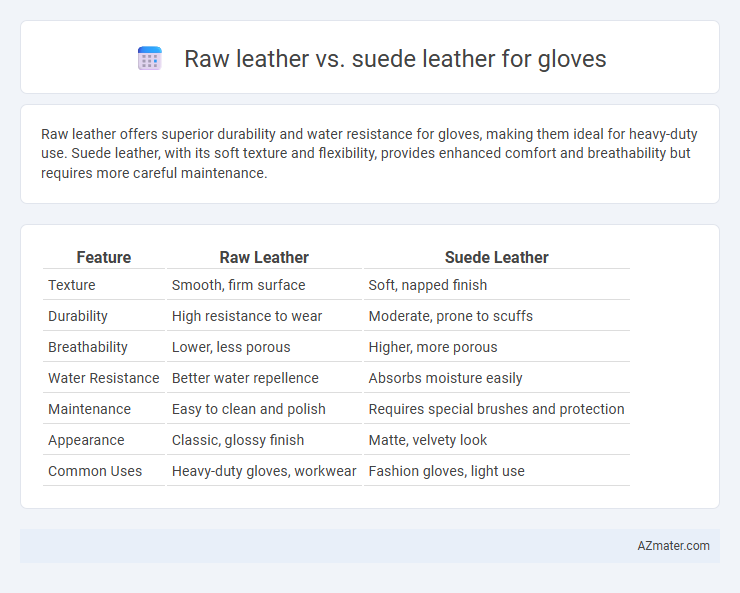Raw leather offers superior durability and water resistance for gloves, making them ideal for heavy-duty use. Suede leather, with its soft texture and flexibility, provides enhanced comfort and breathability but requires more careful maintenance.
Table of Comparison
| Feature | Raw Leather | Suede Leather |
|---|---|---|
| Texture | Smooth, firm surface | Soft, napped finish |
| Durability | High resistance to wear | Moderate, prone to scuffs |
| Breathability | Lower, less porous | Higher, more porous |
| Water Resistance | Better water repellence | Absorbs moisture easily |
| Maintenance | Easy to clean and polish | Requires special brushes and protection |
| Appearance | Classic, glossy finish | Matte, velvety look |
| Common Uses | Heavy-duty gloves, workwear | Fashion gloves, light use |
Understanding Raw Leather: Key Characteristics
Raw leather for gloves retains its natural fibrous texture, providing durability and breathable comfort ideal for heavy-duty use. It features a rough surface with minimal processing, offering superior strength and resistance to wear compared to suede. This type of leather ages well, developing unique patinas that enhance grip and tactile sensitivity over time.
What is Suede Leather? Features and Qualities
Suede leather is a type of leather made from the underside of animal hides, typically lamb, goat, or calf, characterized by its soft, napped finish and velvety texture. It offers enhanced flexibility, breathability, and a lightweight feel compared to raw leather, making it ideal for gloves requiring comfort and dexterity. Key qualities include durability when treated properly, a matte appearance, and a tendency to absorb moisture, which necessitates careful maintenance.
Appearance: Raw Leather vs Suede Leather for Gloves
Raw leather gloves exhibit a smooth, glossy surface with a rich, natural grain that enhances durability and resists stains, making them ideal for rugged use. Suede leather gloves have a soft, velvety texture with a matte finish, offering a subtle, luxurious look but are more prone to dirt and wear over time. The distinct appearance of raw leather emphasizes toughness and refinement, while suede emphasizes softness and elegance, influencing style and maintenance preferences.
Durability Comparison: Which Leather Lasts Longer?
Raw leather gloves demonstrate superior durability due to their dense fiber structure and natural resistance to wear and tear, making them ideal for heavy-duty use. Suede leather, processed from the underside of animal hides, offers a softer texture but is more prone to abrasion and moisture damage, reducing its lifespan compared to raw leather. For long-lasting gloves, raw leather remains the preferred choice due to its toughness and enhanced resilience in harsh conditions.
Comfort and Flexibility in Glove Performance
Raw leather offers superior durability and natural breathability, enhancing glove comfort by conforming closely to hand movements over time. Suede leather provides exceptional softness and a supple texture, allowing for greater flexibility and dexterity in glove performance. Both materials optimize comfort, but raw leather excels in sturdiness while suede prioritizes a lightweight, pliable feel for delicate tasks.
Water and Stain Resistance: How Each Leather Reacts
Raw leather exhibits superior water and stain resistance compared to suede leather due to its dense, non-porous surface that naturally repels moisture and dirt. Suede leather, with its napped, fibrous texture, absorbs water and stains more readily, making it prone to discoloration and damage without proper treatment. Treating suede gloves with water-repellent sprays significantly enhances their resistance but rarely matches the innate durability of raw leather in wet or dirty conditions.
Maintenance and Cleaning: Raw vs Suede Leather Gloves
Raw leather gloves require minimal cleaning, typically involving gentle wiping with a damp cloth and periodic conditioning to maintain suppleness and prevent cracking. Suede leather gloves demand more careful maintenance, as their napped texture is prone to staining and water damage, necessitating specialized suede brushes and protective sprays to preserve softness and appearance. Both types benefit from avoiding excessive moisture and storing in breathable environments to extend lifespan and retain quality.
Cost Analysis: Price Differences Explained
Raw leather gloves typically command higher prices due to the intensive tanning and finishing processes that preserve durability and water resistance. Suede leather gloves, derived from the inner split of the hide, generally cost less because they involve less processing and are naturally softer but less durable. The price difference reflects the trade-off between raw leather's premium toughness and suede's affordable texture and flexibility.
Best Uses: When to Choose Raw or Suede Leather Gloves
Raw leather gloves offer superior durability and protection, making them ideal for heavy-duty tasks such as construction, welding, and industrial work where resistance to abrasion and heat is crucial. Suede leather gloves provide enhanced flexibility, breathability, and a softer feel, making them perfect for lighter tasks like gardening, driving, and casual wear where dexterity and comfort are prioritized. Choosing raw leather gloves is best for rugged environments requiring toughness, while suede leather gloves excel in activities demanding comfort and fine motor control.
Sustainability and Ethical Considerations
Raw leather, derived directly from animal hides, often involves resource-intensive processes with significant environmental impacts, including water pollution and high energy consumption. Suede leather, created by buffing the inner surface of hides, generally uses the same raw material but involves additional chemical treatments that may raise environmental and health concerns. Ethical considerations for both materials depend largely on sourcing practices, with certified, traceable supply chains promoting animal welfare and sustainable farming as crucial factors in reducing the ecological footprint of leather gloves.

Infographic: Raw leather vs Suede leather for Glove
 azmater.com
azmater.com